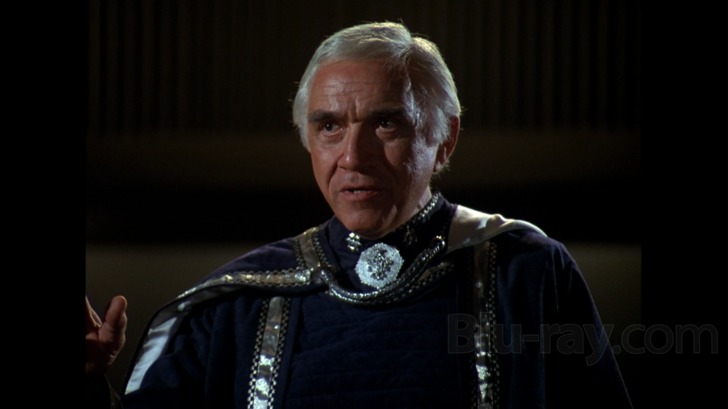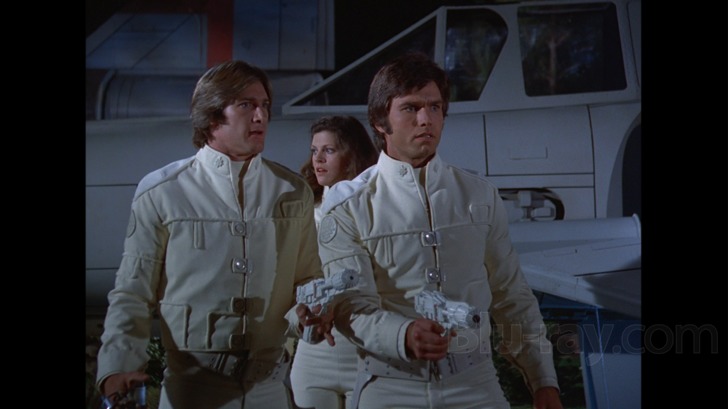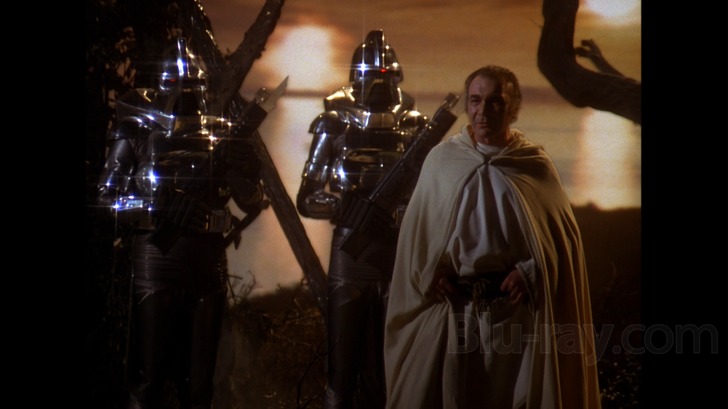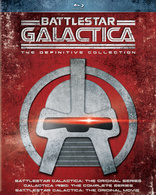Battlestar Galactica: The Definitive Collection Blu-ray Movie
HomeBattlestar Galactica: The Definitive Collection Blu-ray Movie 
Universal Studios | 1978-1980 | 3 Seasons | 1717 min | Not rated | May 12, 2015Movie rating
Movie has not been rated yetBlu-ray rating
| Users | 3.8 | |
| Reviewer | 3.5 | |
| Overall | 3.5 |
Overview
Battlestar Galactica: The Definitive Collection (1978-1980)
After the destruction of the human colonies, the last major fighter carrier leads a makeshift refugee fleet in a search for Earth. Includes Battlestar Galactica 35th Anniversary Theatrical Version, Battlestar Galactica: The Original Series (Widescreen and Full Frame) and Galactica 1980: The Complete Series (Widescreen and Full Frame). See individual titles for their synopses.
| Sci-Fi | 100% |
| Action | 64% |
| Adventure | 60% |
Specifications
Video
Video codec: MPEG-4 AVC
Video resolution: 1080p
Aspect ratio: 1.78:1, 1.33:1
Original aspect ratio: 1.85:1
Audio
See individual releases
Subtitles
See individual releases
Discs
50GB Blu-ray Disc
Eighteen-disc set (18 BDs)
Playback
Region A, B (C untested)
Review
Rating summary
| Movie | 3.0 | |
| Video | 3.5 | |
| Audio | 3.5 | |
| Extras | 3.0 | |
| Overall | 3.5 |
Battlestar Galactica: The Definitive Collection Blu-ray Movie Review
Not quite the definitive collection it's box art implies...
Reviewed by Kenneth Brown May 14, 2015There are those who believe that life here began out there, far across the universe, with tribes of humans who may have
been the forefathers of the Egyptians or the Toltecs or the Mayans. That they may have been the architects of the great
pyramids, or the lost civilizations of Lemuria, or Atlantis. Some believe that there may yet be brothers of man who even now
fight to survive somewhere beyond the heavens.
Fans of the original Battlestar Galactica are a dying breed. The quality of Ronald D. Moore's dark, critically acclaimed
reimagining (2003-
09) had at least one unfortunate side effect: making the 1978-79 series and its more notably flawed follow-up, Galactica
1980, lesser shows; products of a simpler, sillier time when television sci-fi reveled in camp, '70s faux-future fashion, and
chintzy FX. Just as Star Trek: The Next Generation (1987-94) and Russell T Davies and Steven Moffat's Doctor Who (2005-present) refined
and redefined Star Trek: The Original Series (1966-69) and the former Doctor Who (1963-96), New
BSG rendered BSG Classic obsolete in many viewers' minds. Or rather more obsolete than it had already
become. But TV junkies born after 1980 shouldn't be so quick to dismiss the early building blocks of televised science fiction.
While Battlestar Galactica (1978-79) is by no means as influential and important a classic as Star Trek: TOS
or Who, it isn't without its own merit; its own endearing kitsch. Entertaining -- sometimes only because it's so
deliriously, laughably and, yes, lovably cheesy -- Battlestar Galactica is a fun, joyously bouncy ride. More than a
genre milestone in television history, it takes its cues from Star Trek and Star Wars and serves as yet
another bridge between the kids' stuff of '50s sci-fi and the cinematic maturity of modern series, Moore's BSG chief
among them.
Like the best science fiction, Battlestar Galactica extrapolates the unease, discordance and social upheaval of its era,
examining the challenges faced by post-Vietnam American society and culture. The series, however frivolous it may sometimes
seem, tackles serious themes and explores challenging ideas, asking tough questions as often as it asks its audience to
suspend disbelief. Battlestar's social commentary isn't as pointed as Star Trek's, nor are its characters as
thoughtfully conceived or developed. But it's just as integral to the fabric of the series and the over-arcing storyline.
Where Battlestar Galactica (particularly Galactica 1980) fails is in its presentation of that commentary, which
tends to be as inconsistent, wobbly and over-eager as its scripts, performances, and zanier tangents and subplots. It's by no
means a bad show, even thirty-five years later, but it sure can be. Its highs never quite rise to the level of essential sci-fi,
while its lows bottom out, inducing winces and cringes. It's still possible to thoroughly enjoy every minute, though, so long as
you come to BSG and Galactica 1980 with an understanding that it's the concept, not the execution, the
substance, not necessarily the style, and the products of the time, not its timelessness, that makes the saga worth the
investment.


Battlestar Galactica (1978-79): In the deepest regions of space, the fight to save human life from extinction has begun. Hopeful for lasting peace following centuries of intense warfare, the Twelve Colonies gather to sign a treaty with their dreaded enemies, the Cylons. But after an act of treachery on the eve of the ceremony, the Cylons launch a devastating surprise attack, destroying the Colonies' home planets and most of their military strength. A lone flagship Battlestar, the Galactica, remains to aid the surviving colonists on their epic journey for a new home to a far-off legendary planet: Earth. They must survive the pursuing Cylons in a series of battles that will determine the fate of the human race.
Galactica 1980: Thirty years after the events of Battlestar Galactica, the original crew finally makes their long-anticipated descent to Earth. With time running out and the Cylons closing in on their trail, Commander Adama and the Galactica must work harder than ever before to help Earth create the technology necessary for battle.
The 18-disc Definitive Collection box set breaks down as follows:
-
Discs 1-6: Battlestar Galactica - The Original Series (Full Frame)
Discs 7-12: Battlestar Galactica - The Original Series (Widescreen)
Discs 13-15: Galactica 1980 (Full Frame)
Discs 16-17: Galactica 1980 (Widescreen)
Disc 18: Battlestar Galactica - 35th Anniversary Edition Film/Pilot
Alternatively, the 8-disc Remastered Collection box set (available here) breaks down as follows:
-
Discs 1-6: Battlestar Galactica - The Original Series (Widescreen)
Discs 7-8: Galactica 1980 (Widescreen)
Battlestar Galactica: The Definitive Collection Blu-ray Movie, Video Quality 


Both the full frame 1.33:1 and widescreen 1.78:1 versions of Battlestar Galactica and Galactica 1980 are presented in 1080p via AVC MPEG-4 encodes. No surprise there. What is surprising is just how different the two presentations are, and not just in regards to their framing. Everything from color grading to contrast, clarity, shadow delineation and proficiency of the encodes set one presentation apart from the other -- sometimes dramatically -- with the clear winner (to my eyes) being the 1.33:1 full frame image. The widescreen presentation is newly remastered, yes. But the remastering it's been granted is questionable, resulting in a less impressive image than the full frame version... which has also been noticeably (and remarkably) remastered. Just separately. Perhaps from another source. And by another team entirely. Or not. Universal isn't saying. Dizzy yet? I am. The screenshots included with this review speak volumes, though. Before proceeding, take a moment to compare the 1.33:1 and 1.78:1 images.
Full Frame: Worth the Wait
First up, the full frame presentation, which is, by and large, quite striking. The first three episodes of Battlestar Galactica aren't as crisp or colorful as subsequent episodes of the original series, sure. But the bulk of each show's scenes and episodes boast consistently strong and satisfying palettes, nicely saturated skintones, and deep yet forgiving black levels. Delineation, meanwhile, is excellent, with natural shadows that aren't overly aggressive or oppressive, allowing background detail to flourish without appearing artificially enhanced or brightened. Edge definition is crisp and clean too, with very little in the way of ringing, and fine textures are (generally) well-resolved and revealing. As the original photography allows anyway. There are exceptions, of course -- terribly soft shots, FX seams, scenes hindered by difficult lighting, or moments of poor clarity that trace back to the source -- but I found myself marveling far more frequently than grumbling.
There are a small handful of legitimate issues worth mentioning; most pertaining to Battlestar Galactica rather than Galactica 1980, though both are subject to imperfections. The 1.33:1 presentation may feature rejuvenated color, vibrancy, depth and detail, but minor eyesores like scratches, specks and print damage still invade each episode. Many blemishes have been addressed, but many more remain. Thankfully, it's by no means a deal-breaker, and only occasionally distracting. Contrast inconsistencies aren't entirely uncommon either. Nothing major, but still. Fortunately, on-the-cheap noise reduction, artificial sharpening and other intrusive techniques aren't a factor. There are several shots where slight scrubbing and image doctoring are more obvious, but it isn't indicative of anything other than a challenging shot or scene that required more rigorous work.
If any of that scares you off, you've forgotten three important things: 1978, 1979 and 1980. The age of a film or series shouldn't be used to justify the shortcomings of its presentation, but it should be used to adjust expectations. And, overall, my expectations were exceeded...
Widescreen Remaster: Not So Much
...when it comes to the 1.33:1 presentation, that is. The 1.78:1 widescreen remaster isn't as impressive. It too has several distinguishing qualities, but, more often than not, it falls short of the 1.33:1 full screen image. In "Battlestar Galactica: Remastered," a short six-minute featurette included among the set's extras, one of the remastering technicians comment on the goal of the remaster, which essentially boils down to: "fill the screen! Cause that's what modern consumers want!" Not so fast, Starbuck. Taking advantage of my full display is nice in theory, and packaging the series as the studio has is ideal, offering fans and newcomers the best of both worlds: choice. Three cheers for options! However, as is, the widescreen remaster alters much more than the aspect ratio. Too much more.
The 1.78:1 framing itself has been handled judiciously. The widescreen presentation does crop the top and bottom of the 1.33:1 image, but the information lost is rarely crucial. Purists will wince -- particularly as the primary victim of the cropping is the series' production design, costumes and spaceship models -- but heads haven't egregiously been lopped off, key elements in the frame haven't been wiped from existence, and the integrity of the photography hasn't been radically altered. What of that bothersome reduction in clarity you encounter when engaging the "Zoom" feature on your widescreen display? The product of your television literally zooming in on the image to artificially fill the screen? Battlestar Galactica and Galactica 1980's widescreen images feature a similar effect, but to a much, much smaller degree. It's more apparent in screenshots than in motion, mind you, but there is an at-times mild softening of the image that evokes the dreaded "zoom" haze. (The comparative chunkiness of the widescreen image's grain field doesn't help.)
Detail is still commendable, grain is reduced but intact, edge definition isn't crippled by ringing or halos, and, separated from the 1.33:1 presentation, the 1.78:1 remastered image still offers a solid viewing experience. No need to brace yourself for the unwatchable horror some may make it out to be.
But onto the first real problem: the blue tint that's present throughout the widescreen remaster. It's not exactly surprising -- modern films and television shows frequently rely on digital color grading to achieve a similar look -- I'm just not sure what's so appealing about the less colorful endgame. Skintones are less natural, primaries have been diluted, black levels sometimes adopt a faint purple hue, and the visual tone of many scenes has been changed. I've included a few of the more glaring examples for your perusal, although keep in mind most sequences and shots aren't quite as irritating. It's also important to note that, in a properly darkened home theater environment, the difference in color grading between the 1.33:1 and 1.78:1 images isn't as pronounced. Screenshot comparisons make the differences much easier to spot.
Also occasionally troubling is the brightness and contrast of the remastered picture. There's a general darkening of the image, with some shots and scenes being substantially affected. Combined with the change in aspect ratio, the results can be rather disappointing. Crush is more prevalent, subtle background details have been swallowed by hungry shadows, and shots involving Cylons aboard their Raiders and Basestars could be easily mistaken for shots taken from completely different scenes. Again, watching the series in a suitably dark home theater environment will make it harder to identify such issues, but it's still disheartening. And, curse the Lords of Kobol, once you see it, you can't unsee it.
And what of the remaster's cleanup efforts? Pretty good. There are fewer scratches, vertical lines, specks, spots and marks. But there are also new blemishes -- small black squiggles, white splotches, and other suspect anomalies -- more than likely produced by the very techniques meant to eliminate imperfections in the image. The widescreen encode is prone to a few new problems too. Aliasing and faint, ever so faint jaggies creep into the image; often where you'd expect, sharp, angled edges, but also where you wouldn't. Take a look at the following shots, here and here. Notice the slight pixilation along the alien's chin and left cheek in the 1.78:1 image? If not, count your blessings. You probably won't notice the anomaly when the series is in motion. That hasn't stopped members in the forum from eyeballing the aliasing, though; and without screenshots to pore over, pixel by pixel.
Bottom Line: Full Frame!
The widescreen presentation is certainly watchable. Some viewers will prefer it, shortcomings be damned. There may even be a not-so-healthy dose of denial involved, thus the benefit of screenshot comparisons. However, be warned: the widescreen presentation isn't as disappointing as screenshots suggest. Careful, objective analysis is advised. That said, 1.33:1 presentation is terrific. Opinions will no doubt vary. Debate will rage, as it tends to do. And comparisons of all stripes will be made, especially in regards to each presentation's framing. (Comparisons between domestic and international DVD releases and the new Blu-ray remasters are already underway; a growing conversation you can follow or join here.) But aside from the few easily overlooked issues I mentioned before, Battlestar Galactica and Galactica 1980 have never looked better... if you stick with the full frame presentation. Personally, I plan on treating the widescreen remaster as a bonus feature. Forget the black bars. The full frame 1.33:1 presentation is the way to go.
Battlestar Galactica: The Definitive Collection Blu-ray Movie, Audio Quality 


Less important than setting appropriate expectations for the Definitive Collection's video presentations is doing so for Universal's DTS-HD Master Audio 5.1 surround tracks. Both Battlestar Galactica and Galactica 1980 sound quite good for television productions that hail from 1978-80. However, you won't have any illusion that either show's sound designs are more than products of the era. Dialogue is clean and clear on the whole, with only the occasionally muddled or metallic line, and sound effects follow suit, despite some rather thin soundscape elements. The tracks are rather front-heavy too; not a big deal considering the source, so long as you aren't hoping for surprisingly immersive remixes. The rear speakers are used smartly but sparingly, paying respect to the original sound design without forging a completely different experience. And LFE output, though reserved, does a fine job lending weight and presence to low-end elements that might not otherwise make an impression. Moreover, the tracks' support of Stu Phillips' score is fairly full, engaging and enveloping. All told, purists will have a few more nitpicks than the casual listener, but most will be reasonably satisfied.
Battlestar Galactica: The Definitive Collection Blu-ray Movie, Special Features and Extras 


The only special feature exclusive to the 18-disc Definitive Collection set is a 6-minute "Battlestar Galactica Remastered" mini-doc. Otherwise, both the 18-disc Definitive and the 8-disc Remastered Collection sets offer the same supplemental content. (All of which focuses on the original series. No supplemental content is included for Galactica 1980.) If you don't have any interest in the original 4:3 presentations and/or the bundled 124-minute 35th Anniversary edition of the show's pilot (also available separately), you may want to consider the smaller Remastered set. If you want the whole shebang, original 4:3 aspect ratio included, the beefier Definitive Collection box set is for you.
- Audio Commentary (Discs 1 & 7): Actors Herbert Jefferson Jr., Dirk Benedict and Richard Hatch provide a lively, anecdotal commentary for the first three episodes of the series, "Saga of a Star World." The trio swap stories, exhume long- forgotten memories and share fond, personal accounts of life on set and after the show ended. It's not an incredibly insightful three-part commentary, but fans will enjoy it all the same.
- Deleted Scenes (Discs 1-12, SD, 209 minutes): Hundreds of deleted scenes from the original series have been unearthed -- more than three and a half hour's worth, if you can believe it -- and the quality ranges from pretty good to god- awful. Again, no deleted scenes, or any extras for that matter, are available for Galactica 1980.
- Battlestar Galactica Remastered (Disc 12, HD, 6 minutes): A much too short featurette that briefly touches on the techniques utilized to create the series' widescreen remastering.
- Remembering Battlestar Galactica (Discs 6 & 12, SD, 45 minutes): This excellent, revealing and candid 2004 retrospective features interviews with Glen A. Larson, Richard Hatch, Dirk Benedict, Herbert Jefferson Jr., Laurette Spang, Anne Lockhart, Terry Carter, Noah Hathaway, Terrence McDonnell, Rod Holcomb, Alan J. Levi, Winrich Kolbe, Richard A. Colla and Patrick Macnee.
- Glen Larson on the Creation of Battlestar Galactica (Discs 6 & 12, SD, 6 minutes): "We are robots of a higher god." BSG mastermind Glen A. Larson talks about the genesis of the show, the philosophies and greater questions that drove the mythos, the use of classic archetypes and connections to ancient texts, and more.
- Inside Battlestar Galactica: The Cylons (Discs 6 & 12, SD, 5 minutes): Yet another featurette, this one focusing on the Cylons, the poor actors trapped inside the hot, cumbersome robotic costumes, and the challenges of seeing through the uniform's eye mask, contending with extreme heat and frequent bathroom breaks, and... tripping. So much tripping.
- Inside Battlestar Galactica: Working with the Daggit (Discs 6 & 12, SD, 5 minutes): From the Cylons to Muffit II, played by a chimpanzee named Evie. Topics include the chimp's training, stuntwork, stubbornness, and friendship with Noah Hathaway.
- Composing the Score (Discs 6 & 12, SD, 5 minutes): Composer Stu Phillips delves into the series' score.
Battlestar Galactica: The Definitive Collection Blu-ray Movie, Overall Score and Recommendation 


Even the most diehard Battlestar Galactica fans aren't delusional. No one is about to proclaim it a timeless classic. No one is itching to declare BSG more influential in the history of televised science fiction than Star Trek, Lost in Space or Doctor Who. And affection for the series and its follow-up, Galactica 1980, always seem to come paired with built-in rationalizations. It's not as good as modern sci-fi shows, yeah, but it's more fun! Legitimate, not delusional. But there is something to be said for everything Glen A. Larson and his team were attempting to accomplish, some of it very far ahead of its time. There's still value in the original BSG, not to mention a great deal of, you guessed it, fun. Campy and cheesy as it gets, it's the social commentary and big ideas laced throughout the series that give it staying power. It would be a mistake to dismiss it outright. Universal's Blu-ray release makes it easier to discover or re-discover, although the Definitive Collection isn't quite the definitive set some may hope. Extras have largely been recycled and Universal's widescreen remaster is problematic and flawed. Thankfully, the 1.33:1 full frame presentation is much better, the series' DTS-HD Master Audio 5.1 surround tracks are decidedly decent, and the special features included will delight those who haven't seen them before.
